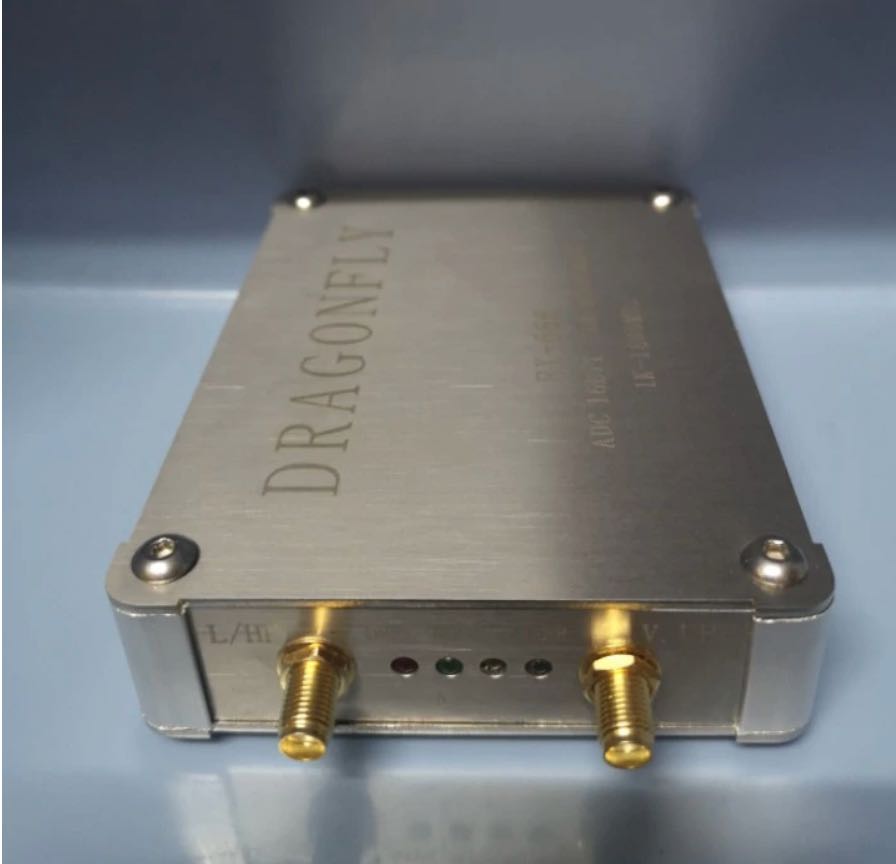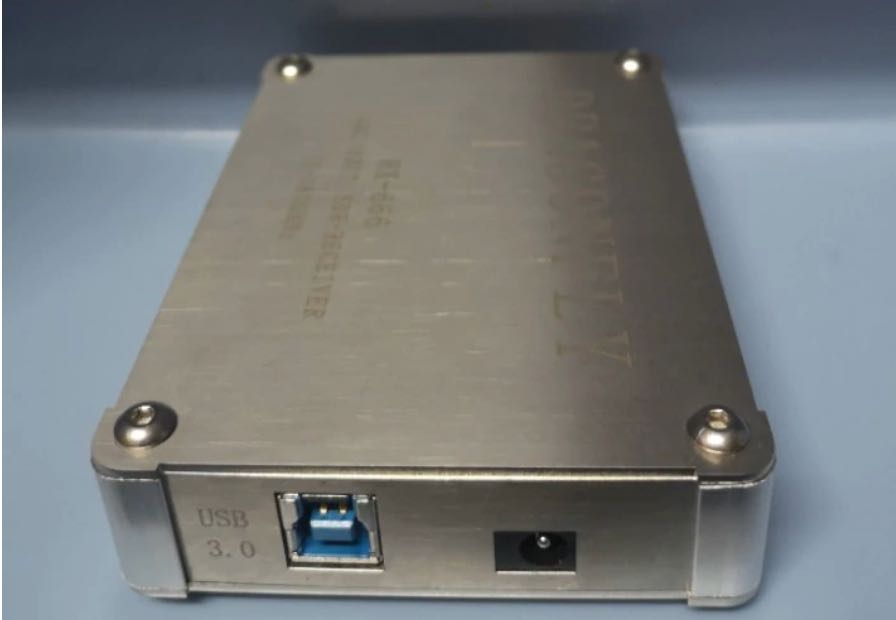Many thanks to SWLing Post contributor, Franco (K4VZ), who writes:
Last night I came across a new SDR receiver from China called ‘RX-666’. On paper its specs are interesting: 16bit ADC, max sample rate 32MHz (in theory one could sample the whole LW+MW+SW bands at the same time), USB 3 interface, and tunable from 1kHz to 1.8GHz.
Its design seems to be a “derivative” of Oscar Steila’s (IK1XPV) BBRF103 SDR – see this post from Oscar – it looks like they upgraded the ADC, made use of a better voltage regulator, and moved to a 4-layer PCB (the original was a 2-layer PCB).
Unfortunately (for Linux people like me) they only have proprietary drivers running on Windows.
Besides the AliExpress store, I saw it is also available on eBay – the AliExpress vendor has two versions, a cheaper one with a ‘standard crystal’, and a more expensive one with an ‘upgraded crystal’; I messaged them earlier to find out what is the difference between the two, but I haven’t heard back yet.
I thought some of those readers of the Post who are interested in capturing large parts of the radio spectrum to decode later might want to look into this SDR receiver.
Thanks for the info on this SDR, Franco. I was not familiar with it. A 16 bit wide band SDR with a 32 MHz working bandwidth is most impressive–I’m sure FM DXers will be following this closely. I’m glad they’re using a USB 3.0 port but am very curious if it can even handle the amount of data should a user initiate a really wide spectrum recording. Perhaps recordings have capped bandwidths?
As a side note, someone should tell the manufacturer that their model number “RX-666” is…well…a culturally sensitive number!
Post Readers: Please comment if you’re familiar with this SDR.



Yes, the Chinasphere has its own ideas of lucky and unlucky numbers. Look at airline flight numbers there: you see a lot of 8s for luck and you don’t see 4s because 4 is associated with death.
As to the operating system to use, is it possible to study the dll files and translate the code into Linux drivers to communucate with the radio? Or can the data flow be intercepted with a tool like Wireshark for crafting a reverse-engineered driver we can use in Linux? I went to Linux years ago and have no intention of going back.
Cheers,
Phil AB9IL
Skywave Linux
Philip,
the good news is that there is no need to reverse engineer the driver, since they ExtIO driver they are shipping is 99% from Oscar Steila’s IK1XPV BBRF103 project, and his code is open source here: https://github.com/ik1xpv/BBRF103.
Also a good understanding of that code should perhaps allow higher sample rates that 32Msps since the LT2208 ADC is rated for a maximum of 130Msps (of course one would have to put in place a better cooling for the ADC and perhaps the USB interface chip, since they would probably get pretty hot).
Franco – K4VZ
Some more useful info here:
– An initial review of the RX-666 by Bjarne Mjelde http://arcticdx.blogspot.com/2020/08/dragonfly-rx-666-new-player.html
– A thread about it on the SDR-radio group: https://sdr-radio.groups.io/g/main/topic/driver_for_dragonfly_sdr/76048589
– One of the AliExpress sellers has this customer review (translation is via Google translate – the original is in Russian): “This is a clone of BBRF103 – look for more information on this name. The seller sends drivers and ExtIO separately by mail – write him a letter. Note that the 32 MHz bandwidth is only available at 0-32 MHz (direct sampling). On VHF the band is 8 MHz. The receiver is picky about the supply current – it works on my laptop, on the desktop i5 there is no longer enough current. In this case, connecting an external power supply to the connector does not help! Those. in terms of power supply, the circuit is not thought out – I need to disassemble the USB cable and solder the external power directly to the +5 Volt USB line. I would recommend the seller to complete the receiver with a USB cable with two plugs – one “power + data” and the second power – to draw current from two connectors on the computer”
Franco
The number reminds me of this one:
https://www.universal-radio.com/catalog/commrxvr/qr666.html
Ha ha! Funny, because I’m not at all a superstitious guy. But I know there will be people who won’t touch a product with that number. Like having no floor 13. 🙂
Quick update:
– the seller answered back saying that the upgraded crystal is the 0.1PPM TCXO
– the same AliExpress store has also the (better named) RX888 SDR receiver: https://www.aliexpress.com/item/4001294301962.html
– the RX888 too is derived from Oscar Steila’s BBRF103 design (it is also mentioned in their description) – in this one it looks like they added heat sinks to the ADC and the USB 3 controller; the case too is a big heat sink
– since it seems both SDRs use the R802T2 tuner for VHF/UHF, the bandwidth above 30MHz is limited to 8-10MHz, which means they probably cover only half or less of the FM BC band
– as per the USB 3 throughput, if they use Cypress FX3 SuperSpeed USB 3.0 peripheral controller, they should be able to stream up to 5Gbps, which should be plenty for a 32MHz sampling rate (I think it comes to about 1Gbps at 16×2 bits per sample)
Franco, maybe you can explain for those of us let technical, why will it do 30MHz bandwidth below 30.00MHz but only 10MHz above that frequency?
Richard, glad to answer.
– If you look at Oscar Steila’s block diagram for the BBRF103 (all these SDR receivers are based on it), you’ll see that there are two antenna inputs, one for HF ( 30MHz).
– in the first case (HF), the path of the signal is pretty simple: it goes from the antenna directly to the ADC chip (with just an attenuator and a 32MHz low-pass filter in between), which means that the ADC ‘sees’ whatever is in the 0-32MHz range directly from the antenna, and it is therefore able to sample the whole 0-32MHz range (the two types of ADC used in these SDRs are the LTC2217 and LTC2208, and both can achieve more than 100M samples per second)
– the path the signal takes in the VHF/UHF case is different: in this case the signal has to go through a tuner (the R802T2) in order to be ‘brought down’ (down-converted) to the 0-32MHz range, that the ADC can process (for instance it wouldn’t be able to process the 200M samples per second necessary to listen to a FM station on 100MHz) – unfortunately the tuner has a bandwidth of “only” 8-10MHz, which means that if you center it at say 100MHz, it will only let through signals from about 95MHz to about 105MHz. After that, the path is the same as the HF signal, but at this point the ADC only sees those 8-10MHz of bandwidth
– speaking of which, there are at least a couple of ways around this limitation: the obvious one would be to use an ADC that can sample say 250M samples per second; they do exist but they are expensive (in the hundreds of dollars range), and they are typically used in professional-grade SDRs; a more interesting approach is to make use of ‘undersampling’, where you take advantage of a normally undesired phenomenon called ‘aliasing’ to actually be able to avoid to have a tuner altogether, and still use the relatively inexpensive ADCs mentioned in the beginning – I see this post is getting a bit long, so if you are interested in this approach, I recommend that you read Oscar Steila’s blog entry about it here: http://www.steila.com/blog/index.php?controller=post&action=view&id_post=25
Hope this helps,
Franco
PS: Thomas, given the interest in this topic, you may want to suggest it to The Spectrum Monitor (perhaps they could have an interview with Oscar IK1XPV on his projects)
If you do the maths, USB3.0 is ~ an order of magnitude faster than required for 16 bit IQ sampling of 32MHz BW. Overhead will vary depending on transfer mode, but it should still be plenty fast enough.
The trick for the average person would be getting together a storage system that could keep up the sustained write speed to record it. Even most SSDs will struggle…
The Wikipedia entry for the number 666 says, “In China the number is considered to be lucky and is often displayed in shop windows and neon signs. In China, 666 can mean “everything goes smoothly” (the number six has the same pronunciation as the character ?, which means “smooth”.”
i wont buy one, like you, i use Linux exclusively and i refuse to buy or install ms_windows just to run an SDR receiver, my airspyhf+ works fine on Linux with CubicSDR & GQRX